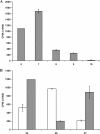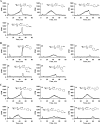Investigating the elusive mechanism of glycosaminoglycan biosynthesis
- PMID: 19628873
- PMCID: PMC2757986
- DOI: 10.1074/jbc.M109.043208
Investigating the elusive mechanism of glycosaminoglycan biosynthesis
Abstract
Glycosaminoglycan (GAG) biosynthesis requires numerous biosynthetic enzymes and activated sulfate and sugar donors. Although the sequence of biosynthetic events is resolved using reconstituted systems, little is known about the emergence of cell-specific GAG chains (heparan sulfate, chondroitin sulfate, and dermatan sulfate) with distinct sulfation patterns. We have utilized a library of click-xylosides that have various aglycones to decipher the mechanism of GAG biosynthesis in a cellular system. Earlier studies have shown that both the concentration of the primers and the structure of the aglycone moieties can affect the composition of the newly synthesized GAG chains. However, it is largely unknown whether structural features of aglycone affect the extent of sulfation, sulfation pattern, disaccharide composition, and chain length of GAG chains. In this study, we show that aglycones can switch not only the type of GAG chains, but also their fine structures. Our findings provide suggestive evidence for the presence of GAGOSOMES that have different combinations of enzymes and their isoforms regulating the synthesis of cell-specific combinatorial structures. We surmise that click-xylosides are differentially recognized by the GAGOSOMES to generate distinct GAG structures as observed in this study. These novel click-xylosides offer new avenues to profile the cell-specific GAG chains, elucidate the mechanism of GAG biosynthesis, and to decipher the biological actions of GAG chains in model organisms.
Figures









Similar articles
-
Synthetic Xylosides: Probing the Glycosaminoglycan Biosynthetic Machinery for Biomedical Applications.Acc Chem Res. 2017 Nov 21;50(11):2693-2705. doi: 10.1021/acs.accounts.7b00289. Epub 2017 Oct 23. Acc Chem Res. 2017. PMID: 29058876 Review.
-
Synthesis of fluorophore-tagged xylosides that prime glycosaminoglycan chains.Bioconjug Chem. 2014 Feb 19;25(2):262-8. doi: 10.1021/bc400396z. Epub 2014 Feb 5. Bioconjug Chem. 2014. PMID: 24499349 Free PMC article.
-
Inhibition of heparan sulfate and chondroitin sulfate proteoglycan biosynthesis.J Biol Chem. 2008 Oct 24;283(43):28881-7. doi: 10.1074/jbc.M805939200. Epub 2008 Aug 14. J Biol Chem. 2008. PMID: 18708345 Free PMC article.
-
Synthesis and assessment of glycosaminoglycan priming activity of cluster-xylosides for potential use as proteoglycan mimetics.ACS Chem Biol. 2013 May 17;8(5):949-57. doi: 10.1021/cb300665u. Epub 2013 Mar 18. ACS Chem Biol. 2013. PMID: 23402705
-
Chemoenzymatic synthesis of glycosaminoglycans: re-creating, re-modeling and re-designing nature's longest or most complex carbohydrate chains.Glycobiology. 2013 Jul;23(7):764-77. doi: 10.1093/glycob/cwt016. Epub 2013 Mar 11. Glycobiology. 2013. PMID: 23481097 Free PMC article. Review.
Cited by
-
Xyloside-primed Chondroitin Sulfate/Dermatan Sulfate from Breast Carcinoma Cells with a Defined Disaccharide Composition Has Cytotoxic Effects in Vitro.J Biol Chem. 2016 Jul 8;291(28):14871-82. doi: 10.1074/jbc.M116.716829. Epub 2016 May 12. J Biol Chem. 2016. PMID: 27226567 Free PMC article.
-
Thioglycosides Are Efficient Metabolic Decoys of Glycosylation that Reduce Selectin Dependent Leukocyte Adhesion.Cell Chem Biol. 2018 Dec 20;25(12):1519-1532.e5. doi: 10.1016/j.chembiol.2018.09.012. Epub 2018 Oct 18. Cell Chem Biol. 2018. PMID: 30344053 Free PMC article.
-
Recent advances on glycosyltransferases involved in the biosynthesis of the proteoglycan linkage region.Adv Carbohydr Chem Biochem. 2021;80:95-119. doi: 10.1016/bs.accb.2021.10.003. Epub 2021 Nov 24. Adv Carbohydr Chem Biochem. 2021. PMID: 34872657 Free PMC article. Review.
-
Different Use of Cell Surface Glycosaminoglycans As Adherence Receptors to Corneal Cells by Gram Positive and Gram Negative Pathogens.Front Cell Infect Microbiol. 2016 Nov 30;6:173. doi: 10.3389/fcimb.2016.00173. eCollection 2016. Front Cell Infect Microbiol. 2016. PMID: 27965938 Free PMC article.
-
Synthesis, conformational analysis and biological activity of xylopyranosyl sulfur-containing glycosides: dependence of sulfur atom configuration.RSC Adv. 2025 Jun 4;15(23):18010-18020. doi: 10.1039/d5ra00498e. eCollection 2025 May 29. RSC Adv. 2025. PMID: 40469227 Free PMC article.
References
-
- Sasisekharan R., Shriver Z., Venkataraman G., Narayanasami U. (2002) Nat. Rev. Cancer 2, 521–528 - PubMed
-
- Lander A. D. (1993) Curr. Opin. Neurobiol. 3, 716–723 - PubMed
-
- Capila I., Linhardt R. J. (2002) Angew. Chem. Int. Ed. Engl. 41, 391–412 - PubMed
-
- Powell A. K., Yates E. A., Fernig D. G., Turnbull J. E. (2004) Glycobiology 14, 17R–30R - PubMed
-
- Salmivirta M., Lidholt K., Lindahl U. (1996) FASEB J. 10, 1270–1279 - PubMed
Publication types
MeSH terms
Substances
Grants and funding
LinkOut - more resources
Full Text Sources
Other Literature Sources

